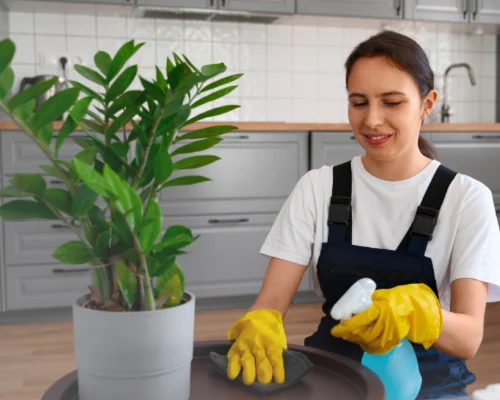
Cleaning and Home Care Specialist
Author Bio:
Yeshi Johanna is a Cleaning and Home Care Specialist who shares practical tips, research-backed methods, and professional insights to help people maintain cleaner, healthier spaces. With a strong focus on eco-friendly solutions and time-saving practices, she writes to make cleaning simple and effective for every home. Her articles on Star Cleaner cover everything from everyday cleaning routines to deep-cleaning strategies and special care for delicate surfaces.
Featured Products
Commercial Cleaning
Stop wasting your precious free time cleaning, relax while we make your premises sparkle
Home Cleaning
Come to your home to a spotless space, let us handle the mess while you enjoy more of what matters most.
Star Cleaner Academy
Unlock your potential — get trained by industry experts and become a certified cleaning professional.
Across Australia, more families and businesses are switching to eco-friendly cleaning. It isn’t just a feel-good choice. It’s a practical way to protect your health, reduce indoor air pollution, and cut chemical waste that would otherwise end up in our waterways. People are paying closer attention to what goes into their homes and workplaces, and for good reason. Many conventional cleaners release volatile organic compounds (VOCs) and leave residues that can irritate airways or trigger allergies and asthma symptoms. Government and health sources highlight fragranced and solvent-heavy products as common indoor air quality concerns. State of the Environment AustraliaYourHomeBetter Health Channel
As a service provider, we focus on green methods that still get tough jobs done. We choose low-toxicity, fragrance-free where possible, and independently certified products, then pair them with smart processes like correct dilution, microfibre systems, and high-efficiency filtration. The goal is simple: a spotless finish without the side effects.

Kids and pets spend more time close to floors, soft furnishings, and other high-touch surfaces. That means more exposure to any residue left behind after cleaning. Choosing low-toxicity and fragrance-free products limits contact with irritants and helps keep little lungs happier. Australian health organisations note that fragranced products and certain cleaning agents can aggravate asthma and other respiratory issues. Opting for products with fewer harsh chemicals and minimal fragrance is a practical first step for a safer home. nationalasthma.org.auAsthma Australia
Indoor air can contain a mix of VOCs from paints, furnishings, and cleaning products. These compounds can contribute to headaches, throat and eye irritation, and can exacerbate asthma and allergies. Australian resources on indoor air quality consistently recommend reducing or avoiding high-VOC and heavily fragranced products, and improving ventilation when cleaning. Choosing certified lower-VOC cleaners and ventilating rooms during and after cleaning are simple actions with a real payoff for comfort and wellbeing. YourHomeState of the Environment Australia
Eco-friendly cleaning isn’t just about what’s in the bottle. Methods and tools matter. For example, microfibre cloths and mops mechanically lift and hold fine particles and bio-load more effectively than many traditional textiles. Studies show microfibre systems can remove soils and bacteria efficiently and often with less chemical, especially when paired with correct detergent use. This helps reduce residues and airborne droplets during cleaning. Western States PEHSUScienceDirect
High-efficiency particulate air (HEPA) filtration in vacuums also makes a difference. Correctly rated HEPA systems capture fine dust, allergens and other particles that would otherwise be re-released into the room. In Australia, guidance for H-class vacuums references compliance with relevant standards for HEPA filter performance and appliance construction. While H-class units are overkill for everyday domestic dust, the underlying principle is sound: use well-maintained equipment with proper filtration to reduce re-suspension. asbestos.qld.gov.au
Everything you rinse down a sink goes somewhere. Detergents, solvents, and fragrances can enter wastewater systems and, in some cases, waterways, where they affect aquatic life and overall ecosystem health. Regulators and environment departments across Australia publish guidance to help businesses prevent pollution and manage wastewater responsibly. The practical takeaway at home or in the office is to prefer readily biodegradable products, use only as much as you need, and never dispose of concentrated chemicals into drains. EPA NSW
Australia has reference standards for assessing ready biodegradability of surfactants and organic substances, such as AS 4351, and many suppliers declare compliance with either AS 4351 or the OECD test methods. Looking for credible certifications and biodegradability claims supported by recognised standards is a sensible way to avoid greenwashing. Standards AustraliaChemform
How do you tell if a product is genuinely “green” rather than just green-labelled? Independent ecolabels help. In Australia, Good Environmental Choice Australia (GECA) certifies products against multi-criteria standards that consider human health, environmental impact, and fitness for purpose. Their cleaning product standard looks at ingredients, manufacturing, packaging, and performance. Choosing GECA-certified products is a simple way to reduce VOCs, hazardous ingredients, and unnecessary environmental load. GecaGecaGlobal Ecolabelling Network
It’s also worth remembering that Australia regulates the introduction of industrial chemicals through AICIS (formerly NICNAS). This oversight covers chemicals used in cleaning products, helping to ensure risk assessments and safe use. If you’re a facility manager or procurement lead, you can ask suppliers how their ingredients are managed under AICIS and what evidence they hold for safety and compliance. AICIS+1
Our job is to give you a consistently clean home or workplace using methods that support health and sustainability. Here’s how we approach it day to day.
Indoor air quality is a growing focus in Australia. The national State of the Environment reporting has flagged VOC exposure from fragranced cleaning and laundry products as a concern for indoor environments, and Australian health advice encourages reducing sources and improving ventilation. While there’s no single indoor air VOC limit that covers every scenario, the trend is clear: fewer emissions are better, and fragrance-free or low-odour options help. Businesses benefit too. Cleaner indoor air can improve comfort, reduce complaints, and support staff with asthma or sensitivities. State of the Environment AustraliaScienceDirect
For families, the biggest wins come from small changes: swap out heavily fragranced sprays and aerosols, use microfibre with a neutral detergent, open windows while you clean, and vacuum regularly with good filtration. For facilities, the gains come from standardising these practices across the board, training staff, and auditing product selections.
People sometimes worry that eco-friendly cleaning means “less clean.” The opposite is true when you pair better chemistry with better process. We use neutral or lightly alkaline detergents that are tough on soil but gentle on surfaces and air. We map the task to the product: kitchens, bathrooms, glass, hard floors, carpets, and high-touch points all get the right method and tools for that surface. When disinfection is required, we choose products that are listed by the TGA for the relevant claims and follow the instructions to the letter. That way, you get the hygiene outcome without collateral impacts from misuse or over-use. Therapeutic Goods Administration (TGA)
Eco-friendly cleaning reduces exposure to VOCs and strong fragrances that can irritate airways and trigger asthma and allergy symptoms. Choosing lower-VOC, fragrance-free products and ventilating while cleaning helps improve indoor air quality. Microfibre and good vacuum filtration also cut dust and allergens.
Yes, when used as directed. Avoid heavy fragrances and harsh solvents, and prefer products with credible certification such as GECA. Always store chemicals out of reach and ventilate the room during and after cleaning
They do when matched to the task and used correctly. Neutral detergents and microfibre remove most soils effectively. Save disinfectants for when they’re needed. In many cases you’ll get equal or better results with less residue and odour.
Choose fragrance-free or low-fragrance products, open windows while cleaning, and avoid mixing chemicals. Regular vacuuming with maintained filters also helps. These steps align with Australian indoor air guidance.
Biodegradable surfactants break down more readily and reduce environmental impact. Look for ready-biodegradability to recognised standards such as AS 4351 or OECD methods, and use only what you need.

Star Cleaner | Sydney, Australia
Created by industry experts with over 30 years of experience in commercial and residential cleaning. Our team shares proven strategies, skills, and ongoing training with all registered Star Cleaners, ensuring professional results every time.
Important Links
Legal Policies
Useful Links
Opening Hours

Star Cleaner Australia acknowledges the Aboriginal and Torres Strait Islander peoples as the First and Traditional Custodians of the lands where we live, learn and work. We pay respect to Elders past and present and recognise their continuous connection to water, sky and Country.
© All Right Reserved | 2025 Star Cleaner Pty Ltd

Get in touch with us using the enquiry form or contact details below.
"*" indicates required fields